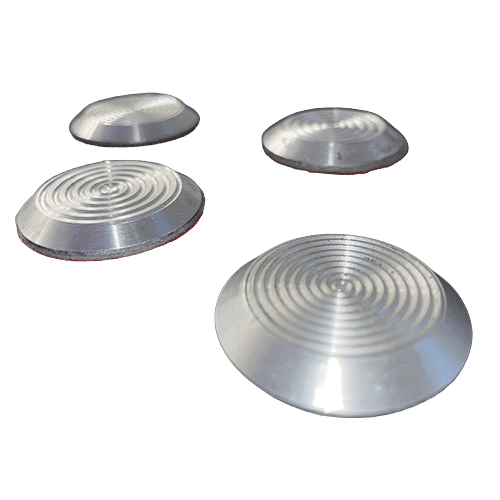Description
Types of tactile cones:
– Tactile cone steel with pin and polyurethane middle KT 04 D35 X 5 (S304/PU) I-25
Steel tactile cone with contrasting polyurethane middle with a diameter of 35 mm and a height of 5 mm + securing pin 25 mm. The tactile cone is designed for marking the beginning of obstacles, stairs or escalators, crossings for visually impaired, blind people. Thanks to the yellow polyurethane insert, the cone is clearly visible to the visually impaired, which is an additional signal function. The steel cone is fastened by means of a steel pin in suitable holes drilled into the floor or pavement.
– Tactile steel cone KT 02 D35 X 5 (S304, S316) I-0
Steel tactile cone with a diameter of 35 mm and a height of 5 mm. Material – steel S304 or S316.
The steel tactile cone can be used as an alternative to tactile tiles both outdoors and indoors. The cones are felt by stepping on or touching with a tactile cane the blind, serve as a warning signal in front of obstacles, stairs, escalators, pedestrian crossings etc. The steel cone is fixed to the floor or pavement with adhesive or double-sided adhesive tape if it serves as a temporary warning sign.
– Tactile indicator aluminium with pin KT 02 D35x5 AL I-15
Tactile aluminium cone with a diameter of 35 mm with a pin to indicate obstacles to blind people. Tactile cone is designed for marking the beginning of obstacles, stairways or escalators, crossings for visually impaired, blind people. The tactile cone is fixed to the floor or pavement by means of a pin.
– Tactile cone polyurethane with pin KT 03 D35 X 5 (PU) I-25
Yellow polyurethane tactile cone with a diameter of 35 mm and a height of 5 mm + PU fixing pin 25 mm. The cone can be used indoors and outdoors for visual and tactile warning of visually impaired and blind people of the beginning of stairs, obstacles, etc. The cone is fixed by means of a polyurethane pin in appropriate holes drilled in the floor or road surface.
Tactile indicators are pedestrian-readable signs mounted on pavement surfaces or indoors to assist blind people. Tactile indicators are used to alert a blind person to obstacles, the beginning of a flight of stairs or roadway, columns, poles, trees and other objects that may be injurious to blind pedestrians. If the colour of the tactile indicator contrasts with the colour of the floor or pavement, the indicator has the additional function of alerting the visually impaired. The material of the tactile indicator affects its durability.






